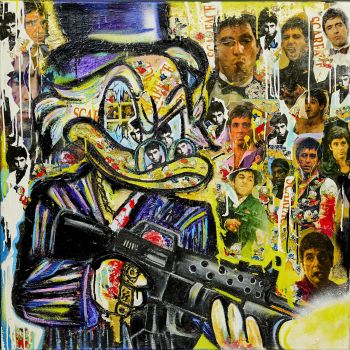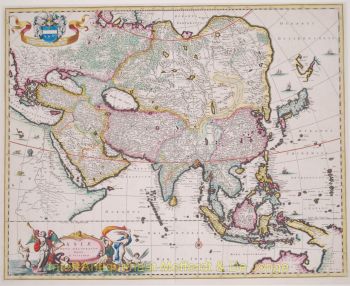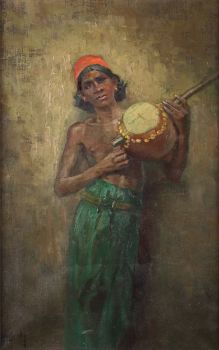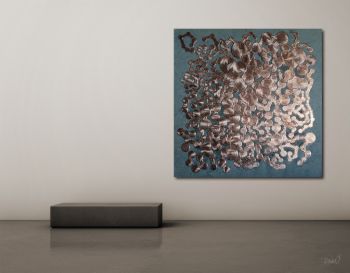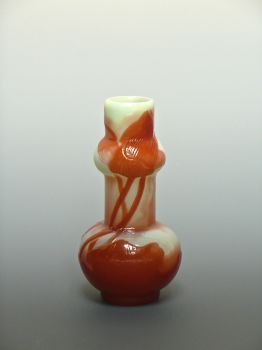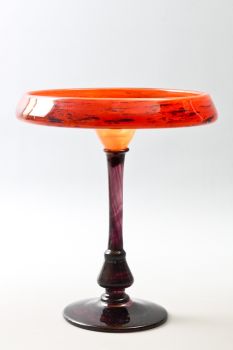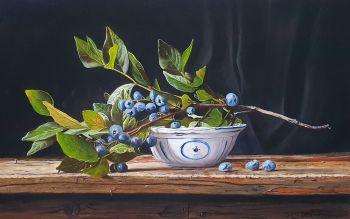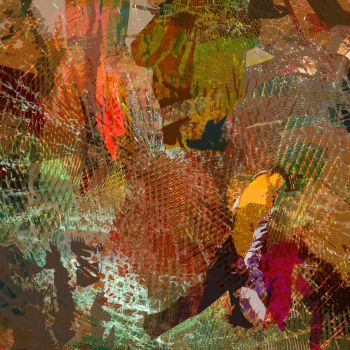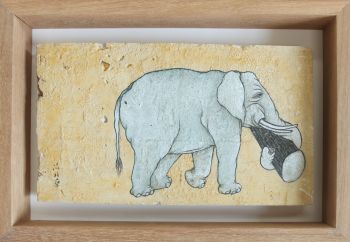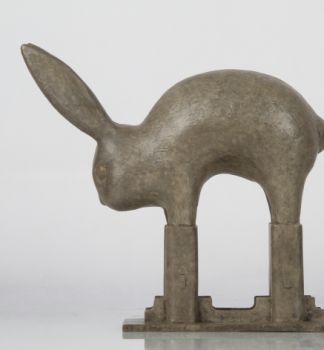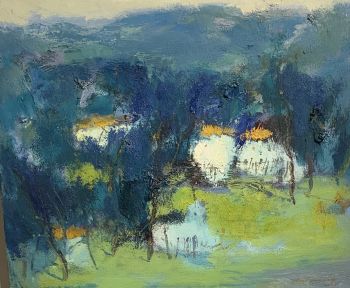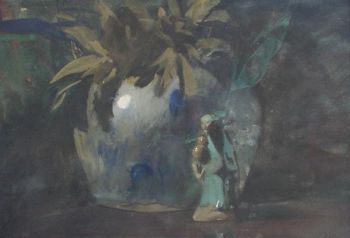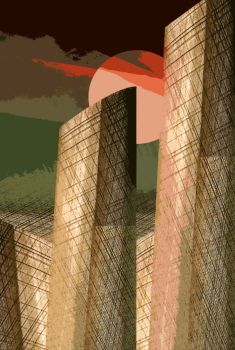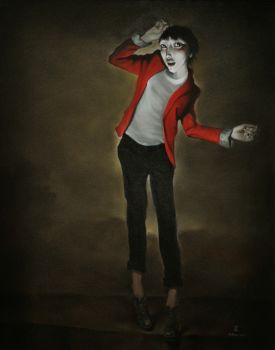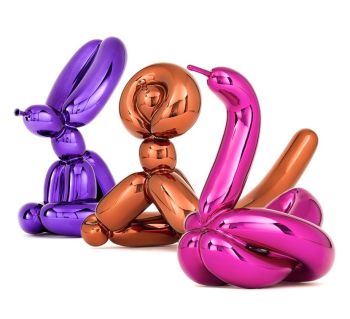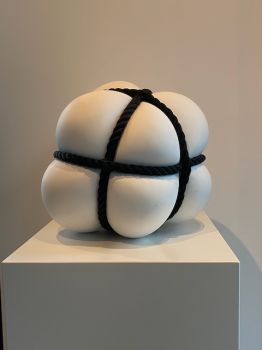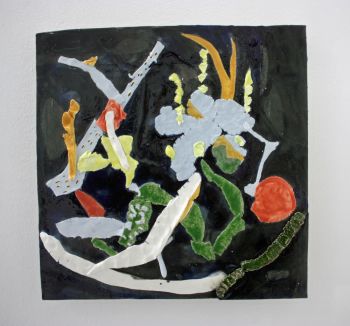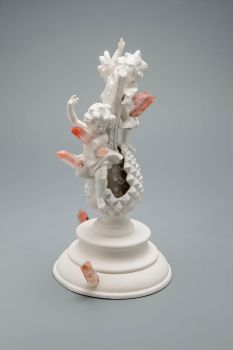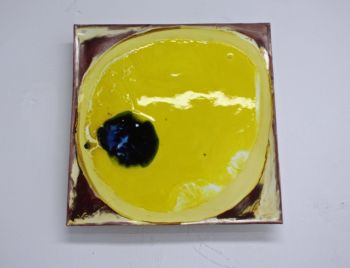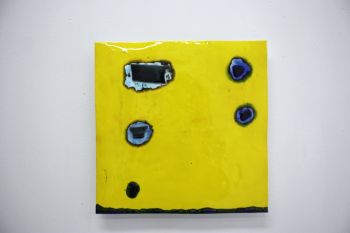A Chinese porcelain blue and white 'Mantou Xin' bowl, Kangxi period (1661-1722) 1700 - 1720
Artista Desconhecido
Porcelana
7.10 cm, ø 19.20 cm
ConditionGood
Preço em pedido
Menken Works of Art
- Sobre arteA blue and white bowl with various Taoist symbolic decorations.
Kangxi period (1661-1722), ca. 1700-1720, China.
The low bowl with interesting convex centre and flared wall.
Inside showing four figures representing Lan Caihe holding a ruyi and a flower basket, slung on a hoe (ancient farming tool) over the shoulder. The convex centre surrounded by a band showing the Eight Treasures (pearl, rhinoceros horn, shell, fishes, never-ending knot, books and a coral stick).
The outside with a band of Wan or Swastika’s in relief with the recess background cleverly showing the biscuit of the porcelain. Underneath the upper swastika band showing the Flowers of the Four Seasons. Underneath the flowers a band of ruyi heads, the bowl resting on a high footring with concave centre.
About Lan Caihe:
Lan Caihe is one of the eight Taoist immortals and the patron saint of florists and gardeners. Sometimes portrayed as a woman, other times as a hermaphrodite, Caihe is a symbol of elusive pleasure and represents innocence and happiness. It is said Lan Caihe wandered the streets as a beggar in worn clothing and with one foot bare, denouncing the elusive pleasures of this fleeting life.
About the Eight Treasures:
Also known as ba bao, this early motif of eight symbols was not merely a decorative pattern that occurred on Chinese works of art, but originally had a symbolic importance reflecting aspirations for status, wealth, and position as well as philosophic allegiance.
About the Flowers of the Four Seasons:
This representation is frequently seen in paintings or depictions on porcelain. A flower or plant representing each of the seasons: plum blossom for winter, grass orchid for spring, lotus for summer and chrysantemum for autumn.
About the Wan or Swastika symbol:
The Wan has been used as a design motif in every imaginable medium. In spite of contrasting views on its origin, it is historically tied to Buddhism and in Chinese folklore it symbolised good luck and eternal abundance. The term Swastika is derived from the Sanskrit su “well” and as “to be”, meaning “so be it” and denoting resignation of the spirit. It is styled the “ten thousand character sign” (wànzì) and is said to have come from heaven. It is described as “the accumulation of lucky signs possessing ten thousand efficacies”. It is also regarded as the symbol or seal of Buddha’s heart and is usually placed on the heart of Shâkyamuni Buddha.
Provenance:
From a private Dutch noble collection.
Identical bowls can be found in several museum collections:
Victoria & Albert Museum London (accession number C.941-1910)
The Frick Collection, New York (accession number 1965.8.75)
Rijksmuseum Amsterdam (object number AK-NM-6845)
Groninger Museum (object number 1899.0360)
Museum Arnhem (inv. nr. GM10.412).
Lit:
Hartog, Stephen - Pronken met Oosters Porselein, p. 67 / nr. 49.
Dimensions:
Diameter 19.2 cm, height 7.1 cm.
Condition (DM for more condition pictures):
Four chips on the mouth rim, furthermore in perfect condition.
Inv. No: A00389 - Sobre artista
Pode acontecer que um artista ou criador seja desconhecido.
Algumas obras não devem ser determinadas por quem são feitas ou são feitas por (um grupo de) artesãos. Exemplos são estátuas dos tempos antigos, móveis, espelhos ou assinaturas que não são claras ou legíveis, mas também algumas obras não são assinadas.
Além disso, você pode encontrar a seguinte descrição:
•"Atribuído a …." Na opinião deles, provavelmente uma obra do artista, pelo menos em parte
• “Estúdio de…” ou “Oficina de” Em sua opinião um trabalho executado no estúdio ou oficina do artista, possivelmente sob sua supervisão
• "Círculo de ..." Na opinião deles, uma obra da época do artista mostrando sua influência, intimamente associada ao artista, mas não necessariamente seu aluno
•“Estilo de…” ou “Seguidor de…” Na opinião deles, um trabalho executado no estilo do artista, mas não necessariamente por um aluno; pode ser contemporâneo ou quase contemporâneo
• "Maneira de ..." Na opinião deles, uma obra no estilo do artista, mas de data posterior
•"Depois …." Na opinião deles uma cópia (de qualquer data) de uma obra do artista
• “Assinado…”, “Datado…” ou “Inscrito” Na opinião deles, a obra foi assinada/datada/inscrita pelo artista. A adição de um ponto de interrogação indica um elemento de dúvida
• "Com assinatura ….”, “Com data ….”, “Com inscrição ….” ou “Tem assinatura/data/inscrição” na opinião deles a assinatura/data/inscrição foi adicionada por outra pessoa que não o artista
Você está interessado em comprar esta obra de arte?
Artwork details
Related artworks
- 1 - 4 / 12
- 1 - 4 / 11
- 1 - 4 / 24
Jan Voerman sr
Still Life with flowers in a Chinese figurine1850 - 1900
Preço em pedidoKunsthandel Pygmalion
Artista Desconhecido
Series of 6 Chinese cups and saucers (Yongzheng period)1722 - 1735
Preço em pedidoKuipers Kunst & Antiek
1 - 4 / 24Samuel Dejong
Anatomia Blue Heritage, Hercules Open2017 - 2019
Preço em pedidoVilla del Arte Galleries
 Com curadoria de
Com curadoria deGallerease Magazine
Samuel Dejong
Anatomia Blue Heritage, Atlas Closed2017 - 2019
Preço em pedidoVilla del Arte Galleries
1 - 4 / 24Artista Desconhecido
Chinese gilt bronze censer, Xuande mark, 18th century, Qing dynasty18th century
Preço em pedidoMenken Works of Art
1 - 4 / 9












